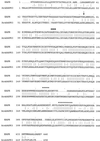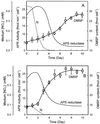Characterization of sulfate assimilation in marine algae focusing on the enzyme 5'-adenylylsulfate reductase
- PMID: 10889258
- PMCID: PMC59072
- DOI: 10.1104/pp.123.3.1087
Characterization of sulfate assimilation in marine algae focusing on the enzyme 5'-adenylylsulfate reductase
Abstract
5'-Adenylylsulfate (APS) reductase was characterized in diverse marine algae. A cDNA encoding APS reductase from Enteromorpha intestinalis (EAPR) was cloned by functional complementation of an Escherichia coli cysH mutant. The deduced amino acid sequence shows high homology with APS reductase (APR) from flowering plants. Based on the probable transit peptide cleavage site the mature protein is 45.7 kD. EAPR expressed as a His-tagged recombinant protein catalyzes reduced glutathione-dependent reduction of APS to sulfite, exhibiting a specific activity of approximately 40 micromol min(-1) mg protein(-1) and Michealis-Menten kinetic constants of approximately 1.4 mM for reduced glutathione and approximately 6.5 microM for APS. APR activity and expression were studied in relation to the production of 3-dimethylsulfoniopropionate (DMSP), a sulfonium compound produced by many marine algae. A diverse group of DMSP-producing species showed extremely high enzyme activity (up to 400 times that found in flowering plants). Antibodies raised against a conserved peptide of APR strongly cross-reacted with a protein of 45 kD in several chlorophytes but insignificantly with chromophytes. In the chlorophyte Tetraselmis sp., APR activity varies significantly during the culture cycle and does not follow the changes in cellular DMSP content. However, a positive correlation was found between cell-based APR activity and specific growth rate.
Figures







References
-
- Ahmed SI, Kenner RA, Packard TT. A comparative study of the glutamate dehydrogenase activity in several species of marine phytoplankton. Mar Biol. 1977;39:93–101.
-
- Alsher RG. Biosynthesis and antioxidant function of glutathione in plants. Physiol Plant. 1989;77:457–464.
-
- Andreae MO, Raemdonck H. Dimethylsulfide in the surface ocean and the marine atmosphere: a global view. Science. 1983;221:744–747. - PubMed
-
- Berendt U, Haverkamp T, Prior A, Schwenn JD. Reaction mechanism of thioredoxin: 3′-phospho-adenylylsulfate reductase investigated by site-directed mutagenesis. Eur J Biochem. 1995;233:347–356. - PubMed
Publication types
MeSH terms
Substances
LinkOut - more resources
Full Text Sources
Research Materials
Miscellaneous

